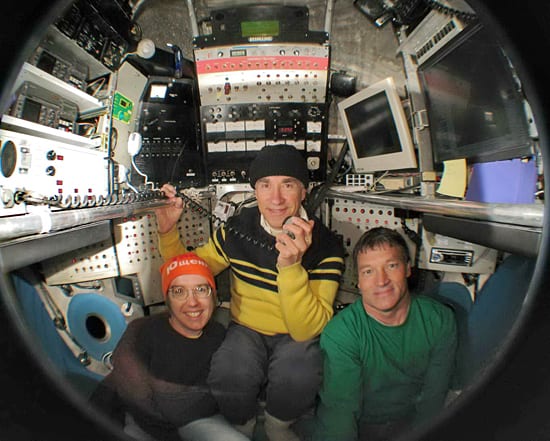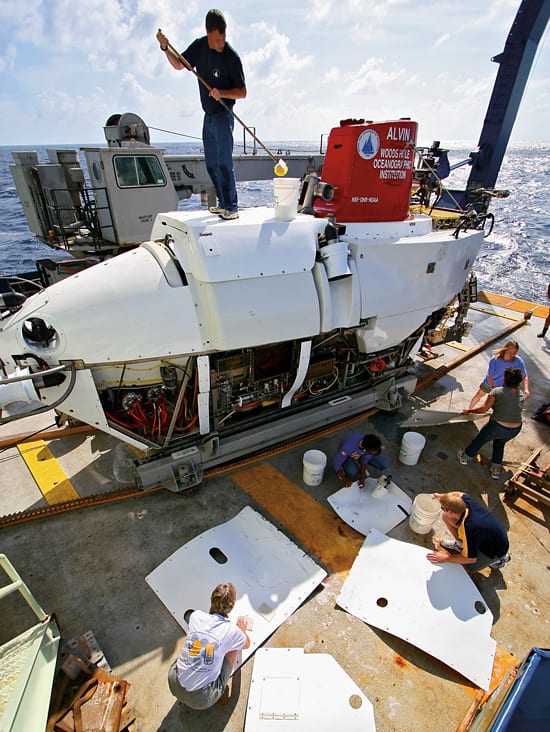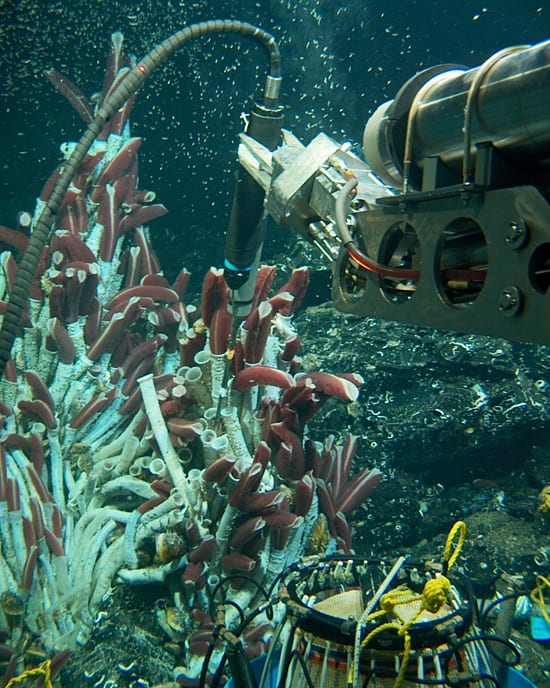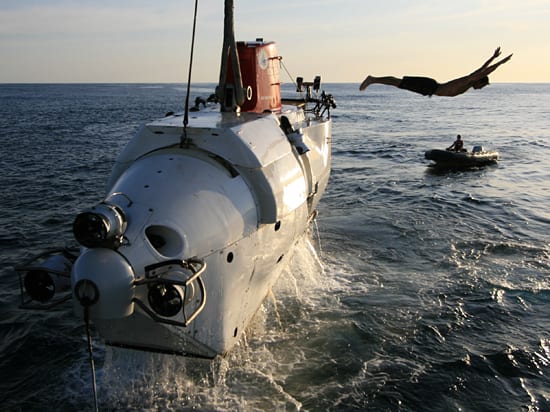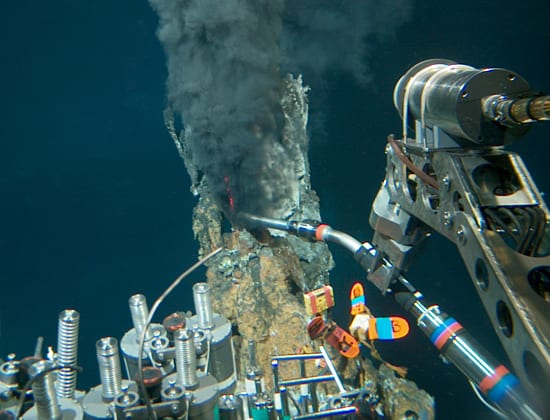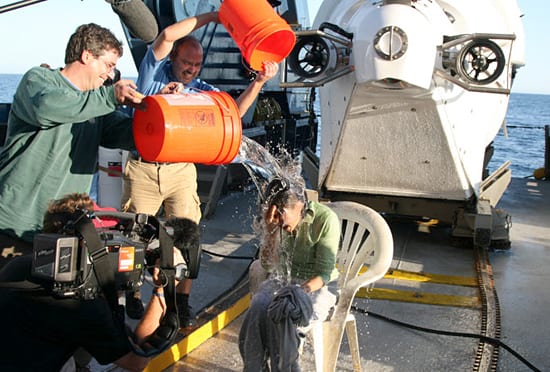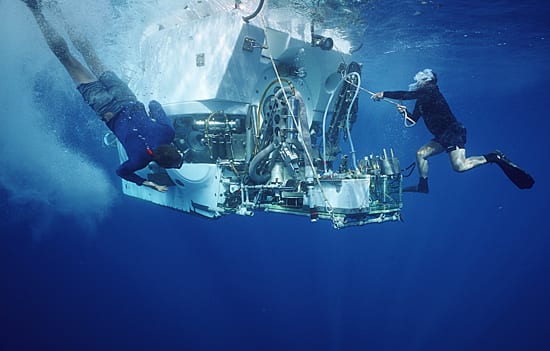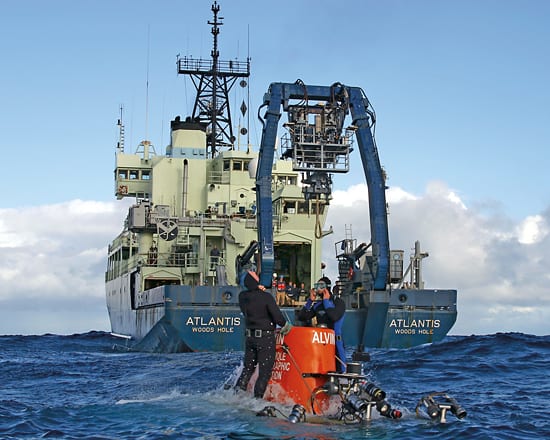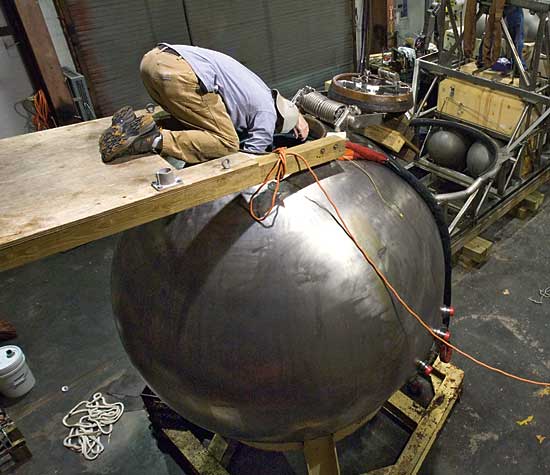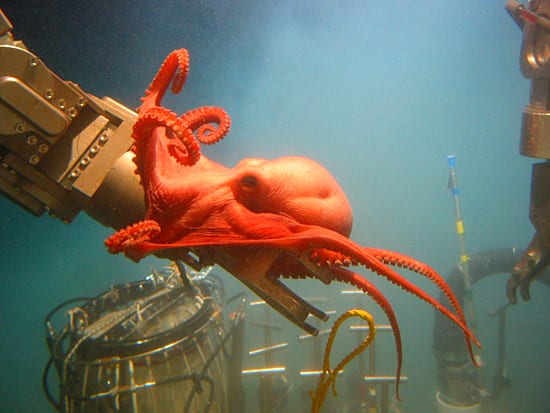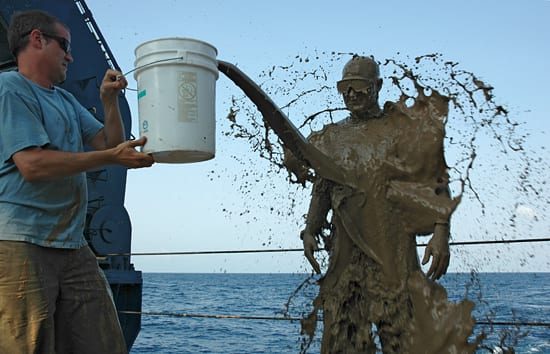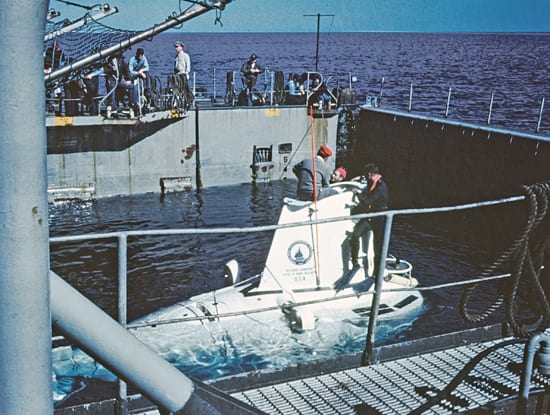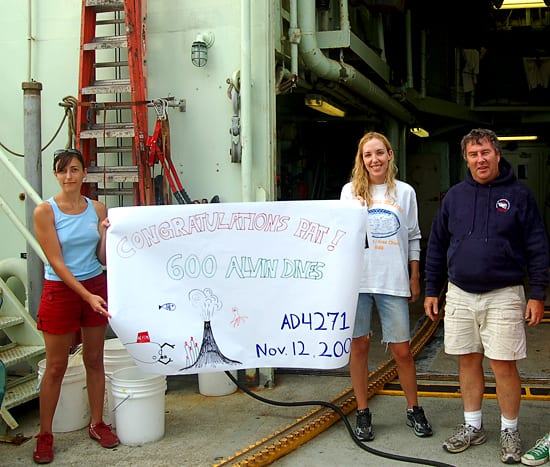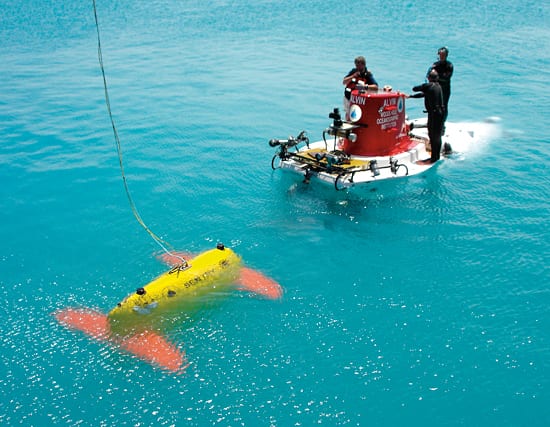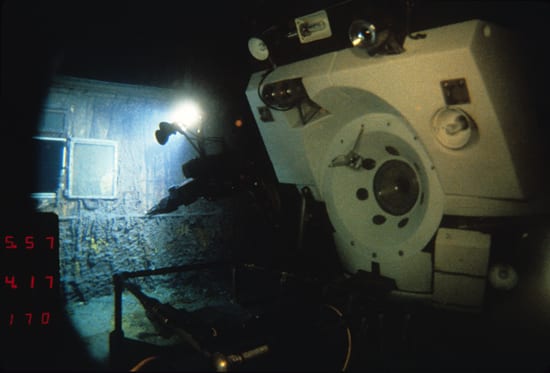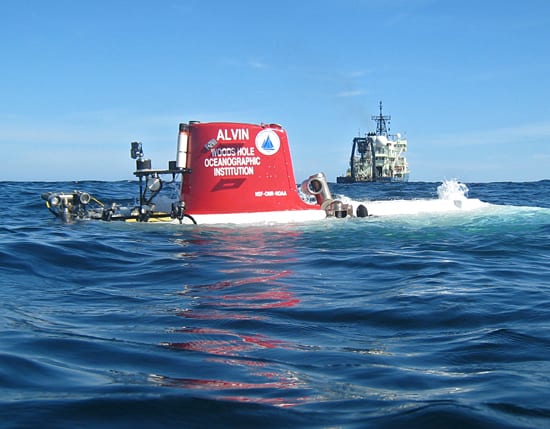 The submersible Alvin prepares for a dive in September 2009. Built in 1964, the hardworking sub helped turn a sunless, freezing marine world into a new frontier. More than 4,000 dives to the seafloor have allowed scientists to discover hydrothermal vents, deep-sea minerals, and hundreds of previously unknown organisms. (Photo by Rod Catanach, Woods Hole Oceanographic Institution)
The submersible Alvin prepares for a dive in September 2009. Built in 1964, the hardworking sub helped turn a sunless, freezing marine world into a new frontier. More than 4,000 dives to the seafloor have allowed scientists to discover hydrothermal vents, deep-sea minerals, and hundreds of previously unknown organisms. (Photo by Rod Catanach, Woods Hole Oceanographic Institution)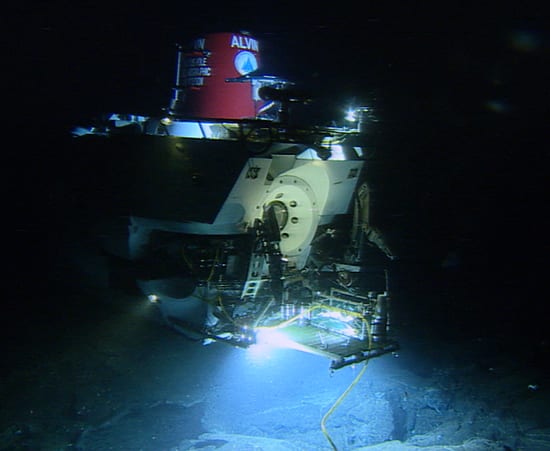 In over 41 years of operation, the submersible Alvin has logged more than 4,300 dives and 30,000 hours exploring the deep ocean, diving a combined total of more than 9 million meters along the way. (Bill Lange, Tim Shank, and the Alvin Group, Woods Hole Oceanographic Institution)
In over 41 years of operation, the submersible Alvin has logged more than 4,300 dives and 30,000 hours exploring the deep ocean, diving a combined total of more than 9 million meters along the way. (Bill Lange, Tim Shank, and the Alvin Group, Woods Hole Oceanographic Institution)- Sweaters and knit hats are typical clothing for scientists and a pilot traveling in the submersible Alvin. Temperatures in the (unheated) submersible drop as the depth increases—in this case, to 1.6 miles depth (2,660 meters) during a September 2007 dive to the Juan de Fuca Ridge offshore Washington and Oregon. "The average temperature outside the submersible is usually around 35°F," said pilot Mark Spear (right). "Inside the sub with all the electronics, and three people's body heat, it maybe gets down to 45 to 50°F. We do have hot coffee, and new this year are nice, fluffy, and cozy fire-resistant fleece blankets! We always take two or three and it resembles a slumber party after the work is done." This dive included doctoral student Katherine Inderbitzen with the University of Miami and scientist Robert Meldrum with the Geological Survey of Canada. (Photo by Mark Spear, Woods Hole Oceanographic Insitution)
- Working on the deck of the R/V Atlantis, pilots and technicians from the Alvin Group scrubbed the submersible on the East Pacific Rise in December 2006. Dried on salt, grime, and the remains of doomed sea life that hitch rides to the surface leaves Alvin in need of a good washing. Cleaning the white exterior "skins" (removed for washing on deck) is just one item on the exhaustive list of maintenance requirements met by operators of Alvin to keep the submersible safe and working properly for the hundreds of researchers it transports each year to the seafloor. (Photo by Lance Wills, Woods Hole Oceanographic Institution)
- pilot on board the Human Occupied Vehicle Alvin uses one of the vehicles two hydraulically-powered robotic arms to probe tube worms on the sea floor of the East Pacific Rise. The arms have clawed "hands" for deploying scientific equipment and collecting marine organisms. They have a maximum extension of 74 inches and can lift up to 150 pounds. (Photo courtesy of Woods Hole Oceanographic Institution)
- After securing the lifting lines used to recover the human occupied vehicle (HOV) Alvin back to its support vessel Atlantis, deckhand Ronnie Whims dives back into the ocean. (Photo by Lance Wills, Woods Hole Oceanographic Institution)
- A mechanical arm on the Alvin submersible reaches out for a sample from a "black smoker" hydrothermal vent along the East Pacific Rise. Black smokers are so named because they can appear as if dark smoke is billowing from them. In fact, the “smoke” is actually iron- and sulfur-rich minerals precipitating from scalding vent waters—as hot as 760°F—meet the icy cold depths.
((Photo courtesy of Woods Hole Oceanographic Institution Archives) - WHOI geochemist Jeff Seewald (green shirt) and biologist Stefan Sievert douse NBC "Today Show" host Ann Curry in icy seawater after her first Alvin dive. In addition to the traditional "baptism," other initiation rites include freezing the first-time diver's sneakers or filling them with whipped cream. New Alvin pilots are sometimes soaked in a mud bath after their first dives. On October 18, 2008, Curry joined Seewald and Alvin pilot Bruce Strickrott for a National Science Foundation-funded dive to study microbes in the Guaymas Basin. (Photo by Sean Sylva, Woods Hole Oceanographic Institution)
- Each dive requires members of the Alvin team to enter the water to check various components and make sure it comes back to the ship safely. (Photo by Rod Catanach, Woods Hole Oceanographic Institution)
- Alvin and the support team work from the WHOI-operated research vessel Atlantis, equipped for moving the 17 metric ton (35,200 pound) submersible into and out of the water. Trained divers (members of Alvin's team) assist with the sub's launch and recovery. (Woods Hole Oceanographic Institution)
- It took two weeks for eight members of the Alvin Group to remove thousands of bolts, hoses, panels, and the submersible's 6-foot titanium personnel sphere during a 2006 periodic overhaul in Woods Hole. The six-month overhaul occurs about every three years. (Photo by Tom Kleindinst, Woods Hole Oceanographic Institution)
- "Most octopuses will let you get close, maybe even touch them, but normally they'll try to run once the manipulator gets close," said Alvin pilot Bruce Strickrott, of his encounter with a deep-sea octopus 2,300 meters down (about 7,500 feet) in the Gulf of Mexico. This female was docile and, instead of swimming away, grabbed the submersible's robotic manipulator arm, used for picking up samples of seafloor rocks and organisms.
- When Mark Spear stepped out of the submersible Alvin as WHOI's newest deep-sea pilot, fellow pilot Gavin Eppard greeted him with a traditional baptism on the deck of R/V Atlantis. Spear is the 36th person to complete pilot training in the 42-year history of the submersible. (Photo by Jeremy Potter, NOAA Office of Ocean Exploration)
- During the search for a U.S. hydrogen bomb lost in the Mediterranean off Spain in 1966, the Human Occupied Vehicle Alvin operated from a Navy dock landing ship. The red beret was adopted as a badge of camaraderie by the Alvin group during its early years after pilot Val Wilson, originally hired as skipper for Lulu, came back from a trip to the Bahamas sporting one. (Photo courtesy of Woods Hole Oceanographic Institution Archives)
- Graduate students Sigrid Katz (University of Vienna) and Carly Strasser (WHOI) greet Alvin pilot Pat Hickey after he completed his 600th dive in the submersible on November 12, 2006. Hickey has now made more dives than any pilot in the sub's four-decade history. Hickey and fellow pilot Dudley Foster (recently retired) have made more than one-quarter of all of Alvin dives. (Photo by Lauren Mullineaux, Woods Hole Oceanographic Institution)
- The new Sentry autonomous underwater vehicle meets the submersible Alvin during a testing expedition off Bermuda in April 2006. Sentry is a robotic underwater vehicle used for exploring the deep ocean; it will often be used to complement Alvin by surveying large swaths of ocean floor to determine the best spots for close-up exploration. Sentry is slated to join the National Deep Submergence Facility in 2008. (Photo by Chris German, Woods Hole Oceanographic Institution)
- he wreckage of RMS Titanic was discovered on the seafloor 25 years ago this week. A year later, a WHOI-led expedition returned with the deep-sea vehicle Alvin and Jason Jr., a prototype robotic vehicle tethered to Alvin via a 60-meter fiber-optic cable and equipped with lights and cameras. WHOI scientist Bob Ballard called it “the floating eyeball.” J.J. photographed Alvin pulling alongside Titanic. "The biggest danger to any dive on Alvin is entanglement on the bottom," wrote former Alvin pilot Will Sellers in a memoir. "If I were to get us stuck and was unable to free the sub, we would become a bit of Titanic history ourselves." (Woods Hole Oceanographic Institution)
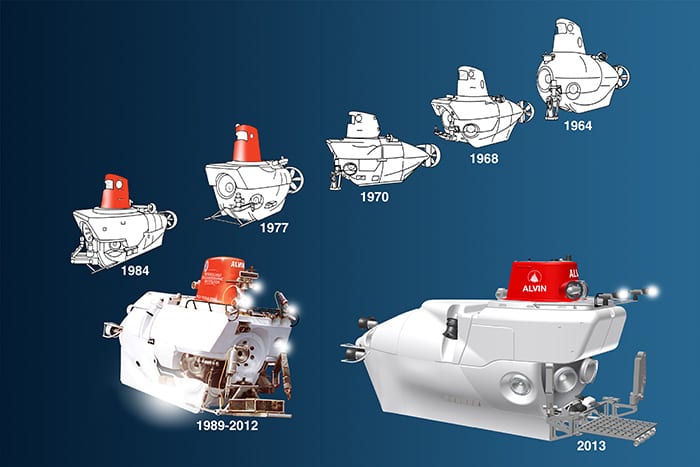 In forty years of operation, the deep submergence vehicle Alvin has evolved and changed its look several times (oldest version at the top right, current version at bottom left, and a future conception of the next Alvin vehicle at the bottom right). In fact, the sub has been completely disassembled every three to five years so engineers can inspect every last bolt, filter, pump, valve, circuit, tube, wire, light, and battery—all of which have been replaced at least once in the sub's lifetime. (Illustration by E. Paul Oberlander, Woods Hole Oceanographic Institution)
In forty years of operation, the deep submergence vehicle Alvin has evolved and changed its look several times (oldest version at the top right, current version at bottom left, and a future conception of the next Alvin vehicle at the bottom right). In fact, the sub has been completely disassembled every three to five years so engineers can inspect every last bolt, filter, pump, valve, circuit, tube, wire, light, and battery—all of which have been replaced at least once in the sub's lifetime. (Illustration by E. Paul Oberlander, Woods Hole Oceanographic Institution)
SEARCH RELATED TOPICS: Underwater Vehicles
Image and Visual Licensing
WHOI copyright digital assets (stills and video) contained on this website can be licensed for non-commercial use upon request and approval. Please contact WHOI Digital Assets at images@whoi.edu or (508) 289-2647.
